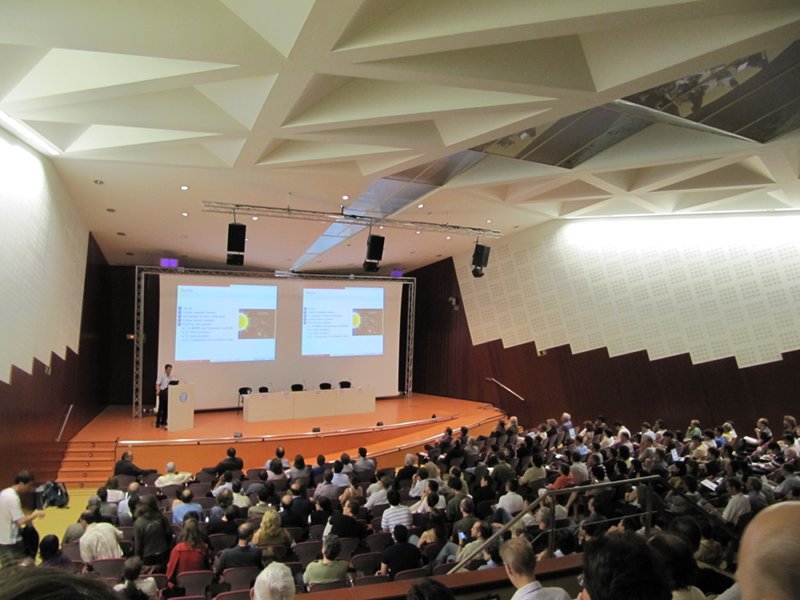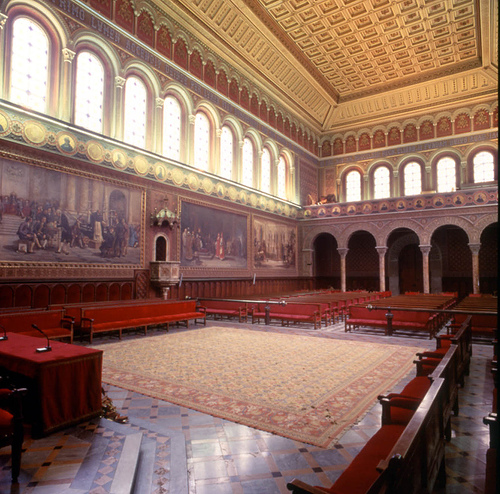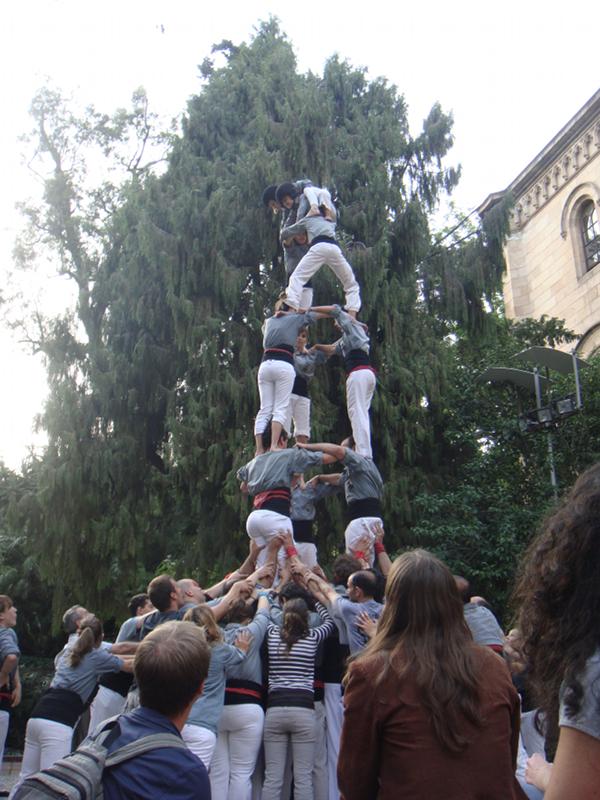Steve Schecter, July 12, 2010
At Snowbird in May 2009, Tere Seara of the Universitat Politècnica de Catalunya announced DSPDEs'10: Emerging Topics in Dynamical Systems and Partial Differential Equations, to be held in Barcelona May 31-June 4, 2010. The meeting would be a joint project of the SIAM activity groups in Applied Dynamical Systems and Analysis of PDEs, the Spanish analogues of AMS and SIAM (Real Sociedad Matemática Española and Sociedad Española de Matemática Aplicada), and the Societat Catalana de Matemàtiques. The language of the last may not be familiar to you--it's Catalan, the language of Catalonia, a medieval principality today divided between the Spanish autonomous region of Catalonia and an adjacent French department.
I knew immediately that I would go. Dynamical systems and PDEs, and especially their intersection, are my mathematical interests. Besides, I like Barcelona, for its exuberant urban life, excellent restaurants, extensive medieval center, and astonishing modernist architecture. I had been there twice, as a student in 1968 on Easter break, trying to catch a ferry to Ibiza, and for Equadiff 1991. That year Equadiff coincided with the attempted military coup against the Soviet reformer Mikhail Gorbachev that ended when Boris Yeltsin led a successful defense of the Russian White House. A highlight of the meeting for me was meeting Yulij Ilyashenko for the first time, on a walking trail near Santa Maria de Montserrat, a mountain abbey where Equadiff participants had gone for a midweek break. He had been helping to defend the Russian White House and had delayed leaving until he was confident the conflict was won.
I arrived for DSPDEs'10 half a day late, thanks to the cancellation of an EasyJet flight from Berlin. The walking route from my hotel to the conference location on the campus of the Universitat Politècnica de Catalunya passed an interesting park entrance that I was too distracted to look at. Later I did: the park was Finca Güell (Güell Estate), for which the Barcelona modernist architect Antoni Gaudí designed some buildings and an entrance in the 1880's. The entrance gate includes a wonderful wrought-iron open-mouthed dragon (see photo) that is unlike anything I know from that period. (Also near the university is Camp Nou, the stadium of the soccer team FC Barcelona.)

Photo: Tom Walton
The conference was a great chance to meet old friends and new, and to hear about some interesting mathematics. I'll describe a highly personal selection of some of the talks. A list of invited talks, together with the slides for many of them, is here. Complete program information is available here.
The most striking talk to me was that of Marco Fontelos, of the
Instituto de Ciencias Matemáticas in Madrid, on "Dynamical systems associated to the formation of some singularities in hydrodynamics." The singularities, illustrated by beautiful photographs of experiments, included the instant of formation of a drop or a bubble by pinch-off, and periodic circular shock waves converging on a central point. The method of analysis was to look for self-similar solutions of appropriately simplified hydrodynamic equations. If the singularity occurs at
\((t,x)=(t_0,x_0)\)
, one looks for a solution of the form
\(u(t,x)=s^\alpha\phi(x/\eta)\)
,
\(\eta=x/s^\beta\)
. Thus, after shifting the origin to
\((t_0,x_0)\), one makes a linear rescaling of both the dependent variable
and the spatial variable, with the rescaling factor depending on time. Such a solution is the solution of an ODE boundary value problem and should represent the phenomenon under study. It is an equilibrium of the PDE after rescaling the the dependent and space variables. One can study its stability as a PDE solution by the additional change of variable
\(\tau = \ln s\)
, which converts algebraic approach to the equilibrium into exponential approach, and typically allows study of the linearization by looking for spectrum in the usual way. Fontelos showed examples in which the spectrum lies to the left of the imaginary axis (attracting equilibrium) or has a simple zero eigenvalue, which can be treated as a center direction for the PDE dynamics. The discussion of converging shock waves was different: one looks for period solutions in transformed variables, but as best I could tell, the equations satisfied by the periodic solutions were PDEs, not ODEs.

The auditorium, with double vision projector.
Related to Fontelos's talk was the talk of Eugene Wayne, of Boston University, on "Dynamical systems theory and the two-dimensional Navier-Stokes equations." Wayne focussed on Oseen vortices, which are a one-dimensional family of explicit self-similar solutions of the 2-dimensional Navier-Stokes equations in vortex form, of the form
\(\Omega (x,t)=A(t+1)^{-1}\phi(x/\eta)\)
,
\(\eta=(t+1)^{1/2}\)
. (\(t+1\) is used instead of \(t\) so that initial conditions can be prescribed at
\(t=0\).) Similar to Fontelos's talk, the similarity solutions are equilibria of the PDE after rescaling the the dependent and space variables, and one can study their stability by the additional change of variable \(\tau =\ln(t+1)\). The linearized operator turns out to have its spectrum to the left of the imaginary axis, except for a simple eigenvalue 0, which corresponds to the line of Oseen vortices. Hence the line of Oseen vortices is asymptotically stable: a solution that starts near it converges to some Oseen vortex. With the aid of Lyapunov functions, Wayne identified a larger set of initial conditions that converges to an Oseen vortex.
I also want to mention the talk of Arnd Scheel, of the University of Minnesota, on "Coherent structures and Liesegang patterns." When a concentrated solution of a salt is added to the top of a test tube that contains a dilute solution of the salt in a gel, the salt slowly diffuses into the gel. Often rings of precipitate form down the tube, with the spacing between the rings increasing geometrically as one goes down the tube. This phenomenon was noticed in 1896 by the German chemist R. E. Liesegang; it qualifies as one of the earliest identified examples of pattern formation in reaction-diffusion systems. This process may explain the colored bands that occur in many minerals. Despite the intensive study of pattern formation in reaction-diffusion systems in recent decades, Liesegang patterns have been little studied by mathematicians.
Scheel presented a reaction-diffusion model for precipitation in which a cubic function governs the transition from solution to precipitate. In equilibrium, a given concentration of solute (within a certain range) is consistent with either a low or a high concentration of precipitate. Of course the two stable equilibria are separated by an unstable equilibrium. Traveling waves exist in which the unstable equilibrium is invaded by one of the stable equilibria; for example, a precipitation front can sweep through a gel prepared in the unstable state. In addition, Scheel and collaborators have shown that this precipitation front can be preceded by a periodic pattern whose length stays constant or grows linearly in time.
Using "spatial dynamics," Scheel has shown that Liesegang patterns, with their characteristic spacing, can form when such a system is subjected to forcing by constantly adding solute near one end.
A highlight of the conference was an evening of lectures by Ingrid Daubechies, of Princeton, and Douglas Arnold, of Minnesota, in the Paranimf (auditorium) of the Universitat de Barcelona in downtown Barcelona. This must be one of the world's great university lecture hall (see photo).

Photo: Jesús Corrius
Arnold discussed three aspects of golf: the swing, most simply modeled as a double pendulum (the arms and the club); the impact of club head on ball, in which much of the momentum of the club head is transferred to the ball according to a simple formula; and the flight of the ball after it is hit. One can of course calculate the parabolic arc the ball would follow if the only force were gravity, but one must also take into account air resistance. Gravity plus air resistance decompose into drag plus lift. Drag is caused by friction between ball and air and by the difference in pressure ahead of and behind the ball. In general drag increases with Reynolds number, a dimensionless quantity that, for a spherical golf ball in flight, equals the product of the density of air, the diameter of the ball, and the ball speed, divided by the viscosity of air.
At a typical ball speed the Reynolds number is about 160,000. At a somewhat higher Reynolds number (250,000), drag begins to decrease as Reynolds number increases. The reason is boundary layer separation, which leads to turbulence behind the ball and thereby mixes surrounding air with the low-pressure air in the ball's wake, thus reducing drag.
Importantly for golf, a suitably rough spherical ball experiences this reversal at a lower Reynolds number, around 50,000, which, unlike the figure for a smooth ball, is attained under realistic conditions. The reduced drag is responsible for roughly doubling the distance a golf ball can be hit. Since the mid-19th century, the manner of roughening a golf ball to take advantage of this effect has been gradually improved. Arnold showed simulations demonstrating that computational science is today becoming capable of modeling the details of flow past dimple patterns on golf balls, which should lead to further progress.
The science talks were followed by a very pleasant tapas and wine party the building lobby. In the courtyard a team of Catalan castellers built human towers. (Castell means castle). It works like this: a circle of burly guys at the bottom supports, eventually, happy kids who scramble to the top (see picture).

Arnd Scheel and Margaret Beck admiring the Castell.
As the party broke up, we visitors were left to contemplate how a Catalan castell can serve as a metaphor for a scientific meeting.